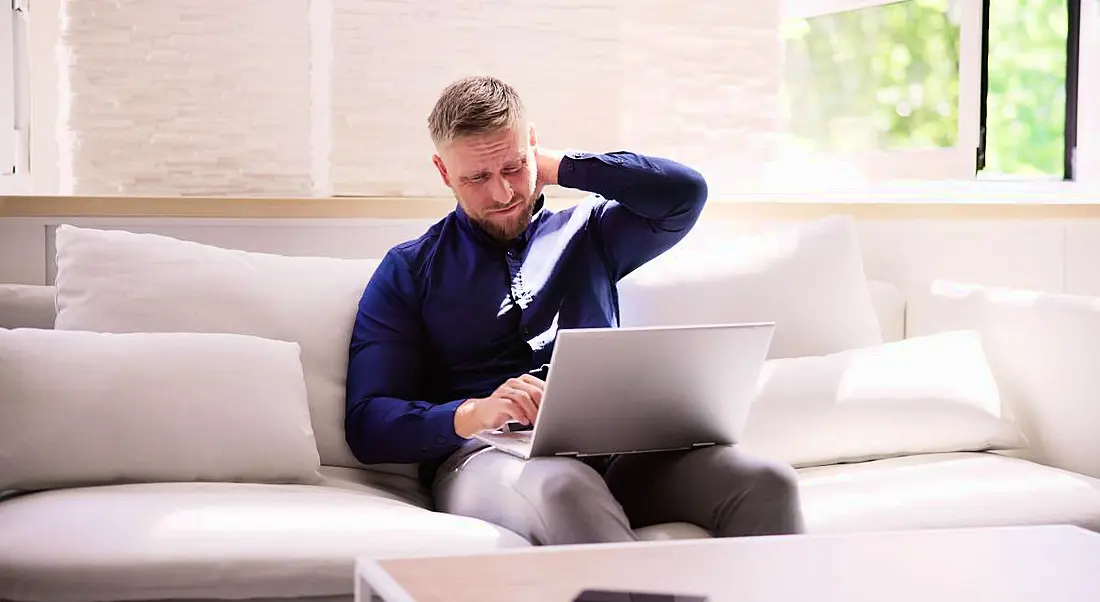Less social contact, more sedentary lifestyles and poor work-life balance are some of the reasons why working from home is not always healthy, say these HR leaders.
Working from home all the time was once the best thing for protecting people’s health, but many argue that this is no longer the case. During the pandemic, the good parts of a regular work routine like socialising, exercise, healthy eating – and even just getting out of the house – were put on the back burner.
But now that there is no need for self-isolation, why aren’t more workers insisting on returning to the office? Some years on from the pandemic, Damien McCarthy, CEO of Irish consultancy HR Buddy, says that a lot of people may be holding on to what they see as their right to work from home even if their stubbornness might be harming them. He reckons there are a lot of people not suited to working from home all the time and that the practice should come with “a health warning”.
Mary Connaughton, director of HR organisation CIPD Ireland, also believes that working from home all the time is not always the best solution for workers’ wellbeing. She is an advocate of the flexible approach, which is very different from always remote or always in the office.
Last year, she expressed concerns that the Irish Government’s plan to bring in a remote working bill did not provide much in the way of flexible working. The bill was later updated and the right to request remote working has been integrated into the Work Life Balance Bill, which became law earlier this year.
Physical health risks
But both Connaughton and McCarthy believe society needs to be more open about the downsides of remote working – particularly in terms of health and wellbeing. Research by the likes of Stanford University has shown, for example, that workers who work from home are more sedentary than their counterparts. As Connaughton points out, walking around an office and travelling to and from the home to the workplace involves movement. People who work from home walk a couple of steps from their bedroom to their home workstation and often have no reason to budge all day. Not only is sitting in one position all day bad for your exercise intake, it’s also not good for your ergonomic health.
“Employers are responsible to make sure people are working safely and have safe equipment to use,” says Connaughton. During the pandemic, when we moved to remote working initially, many employers got their employees to do a risk assessment of their physical work environment – such as their desk space, their chair and their wires.
Since the pandemic, Connaughton observes that “attention on that has dipped,” and workers are being left to their own devices. “So the question is, how aware are employers of the risk that employees face and how aware are the employees of the risks that they accept on a day-to-day basis,” says Connaughton.
There is a very real risk of repetitive strain injury due to inadequate physical support for digital workers. “People aren’t always standing and sitting correctly and end up suffering from that,” says Connaughton. “There are risks from the environment that people are working in that probably weren’t there before.”
McCarthy agrees. “Regardless of where the work environment is, the employer does have the responsibility to provide a workstation and an ergonomically appropriate work chair and so on. That possibly wasn’t something that was done when a lot of organisations kind of were forced into remote working during the pandemic.”
Difficulties in disconnecting
He says that while employers could be excused for rushing the whole transition to remote working a few years ago, that is not the case anymore. “Another area that I have big concerns about is people disconnecting from their work,” he points out. “It’s so hard now to disconnect because of the technology that we all carry around in our pockets through our smartphones. There’s a struggle with disconnect anyway, but when you’re working from home, that’s an even bigger challenge.”
Connaughton feels that there is “more pressure to respond” to emails and notifications on employees working from home. This perhaps isn’t felt as much in the office as employees have time and space to step away from their screens between meetings, meaning there is “more real social connection”.
Remote can be ‘much less personal’
“If you’re totally remote, for some individuals who don’t have a strong social network, they can really miss that interpersonal interaction,” she adds. “Conversations that happen when you bump into people are much more personal and can be much more supportive. It’s easier to go up to somebody face to face and say ‘Can you help me with this I’m struggling with it’ or ‘This happened to me in my personal life,’ – and have a chat about it.”
Even from her own point of view, Connaughton has found that Teams and Zoom calls are “much less personal” because we use them in a much more functional way. McCarthy is concerned that young people who have never been in workplaces are slipping through the cracks. He says we need to rethink our approach to remote working if we don’t want to have a generation of people down the line who feel as though they have missed out on the social side of working life. As he says, young people are constantly told that working from home is “a dream” but the reality for them can be different – working eight hours a day from dingy accommodation with little support or opportunities to feel like they belong.
More maturity is needed
Working parents – another group that is constantly told how great remote working can be for them – are also not always thriving. “The work-life balance isn’t being achieved because even for working parents, they’re working, exhausting themselves throughout the day and then returning to work at eight, nine o’clock, maybe 10 o’clock in the evening, when they put their kids to bed,” says McCarthy. “That isn’t life-work balance. That’s just getting through things.”
“This is a public health matter,” he says of the remote working discussion. “It isn’t just something that employers and workers need to focus on. I think the Government should be focusing on this.” If remote working is not “done well” by all of us there will be “long-term health impacts such as loneliness, isolation, increased migraines and eyesight damage,” McCarthy adds.
“I still think we’re on a bit of a journey where maybe we need to mature a little bit and open our eyes to make sure that we’re doing this right, we’re doing this better and that we’re not creating future problems for ourselves.”
10 things you need to know direct to your inbox every weekday. Sign up for the Daily Brief, Silicon Republic’s digest of essential sci-tech news.




